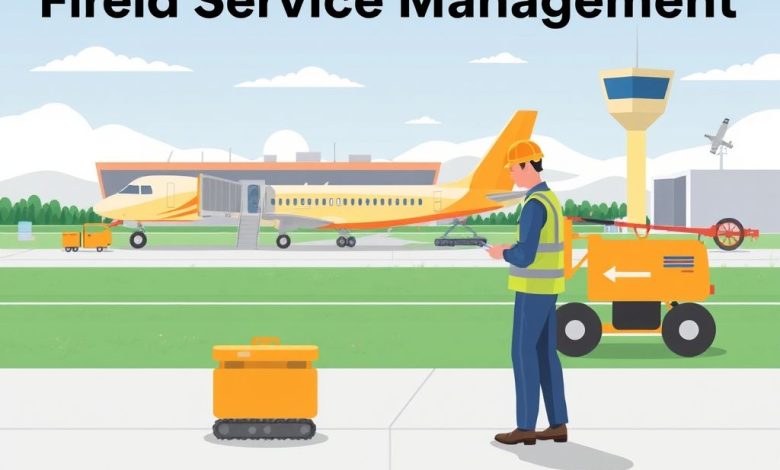Field Service Management for Airport Equipment Calibration Efficient Maintenance Strategies

Introduction
Field Service Management (FSM) is a crucial aspect of modern business operations, particularly in industries where equipment maintenance and calibration are essential for safety and efficiency. In the context of airport equipment calibration, FSM plays a vital role in ensuring that critical machinery is properly maintained and calibrated to meet stringent aviation standards. This article will explore the importance of FSM in airport equipment calibration, its challenges, best practices, and future trends.
- The Importance of FSM in Airport Equipment Calibration
- Challenges in Airport Equipment Calibration FSM
- Best Practices for Implementing FSM in Airport Equipment Calibration
- Invest in Comprehensive FSM Software
- Develop Standard Operating Procedures (SOPs)
- Provide Ongoing Training
- Implement Quality Control Measures
- Leverage IoT Technologies
- Foster Collaboration Between Departments
- Future Trends in FSM for Airport Equipment Calibration
- Artificial Intelligence Integration
- Augmented Reality Training
- Blockchain for Supply Chain Management
- Increased Focus on Sustainability
- Conclusion
The Importance of FSM in Airport Equipment Calibration
Airport equipment calibration is a critical process that ensures the accuracy and reliability of various systems used in air traffic control, navigation, and aircraft operations. These systems include radar, weather monitoring equipment, navigation aids, and communication devices. Proper calibration is essential for:
- Ensuring the safety of aircraft operations
- Maintaining accurate weather data for pilots
- Preventing system failures that could disrupt air traffic control
- Complying with regulatory requirements set by aviation authorities
Field Service Management software helps streamline this process by providing tools for scheduling, dispatching, and tracking field technicians. This enables airports to:
- Improve response times to equipment failures
- Reduce downtime of critical systems
- Ensure compliance with regulatory requirements
- Optimize resource allocation for calibration tasks
Challenges in Airport Equipment Calibration FSM
Despite its importance, implementing effective FSM for airport equipment calibration presents several challenges:
Regulatory Compliance
Aviation authorities such as the Federal Aviation Administration (FAA) set strict regulations for equipment calibration. Field service managers must ensure that all calibration activities adhere to these standards, which can be complex and time-consuming.
Remote Locations
Many airport equipment installations are located in remote areas, making it challenging to dispatch technicians quickly. This requires careful planning and scheduling to minimize downtime.
Specialized Knowledge
Airport equipment often requires specialized knowledge to calibrate properly. Ensuring that field technicians have the necessary expertise can be difficult, especially if they work on multiple types of equipment.
Data Security
Field service management software may contain sensitive information related to aircraft safety and security protocols. Ensuring the confidentiality and integrity of this data is crucial.
Best Practices for Implementing FSM in Airport Equipment Calibration
To overcome the challenges mentioned above and implement an effective FSM system for airport equipment calibration, consider the following best practices:
Invest in Comprehensive FSM Software
Implement a robust FSM solution that includes features such as:
- Scheduling and dispatching tools
- Mobile workforce management capabilities
- Inventory tracking
- Customer relationship management (CRM) functions
- Reporting and analytics
Look for solutions specifically designed for aviation industry needs, such as those that integrate with existing airport management systems.
Develop Standard Operating Procedures (SOPs)
Create detailed SOPs for each type of equipment calibration task. These should include:
- Step-by-step instructions
- Required tools and materials
- Safety precautions
- Acceptance criteria for successful calibration
Ensure that all field technicians have access to these SOPs through mobile devices.
Provide Ongoing Training
Invest in regular training programs for field technicians to keep them updated on:
- New equipment technologies
- Changes in regulatory requirements
- Best practices in FSM
- Troubleshooting techniques
Consider partnering with equipment manufacturers or industry associations to provide expert training.
Implement Quality Control Measures
Establish a quality control process to ensure that all calibration activities meet required standards. This may include:
- Regular audits of calibration records
- Peer review of technician work
- Continuous improvement initiatives based on feedback and performance metrics
Leverage IoT Technologies
Incorporate Internet of Things (IoT) devices and sensors into your FSM system. This can help:
- Monitor equipment health remotely
- Predict maintenance needs before failures occur
- Automate some aspects of the calibration process
Foster Collaboration Between Departments
Encourage close collaboration between FSM teams, equipment operators, and air traffic control personnel. This helps ensure that:
- All stakeholders are aware of ongoing calibration activities
- Potential conflicts are identified early
- Information sharing improves overall efficiency
Future Trends in FSM for Airport Equipment Calibration
As technology continues to evolve, several trends are likely to shape the future of FSM in airport equipment calibration:
Artificial Intelligence Integration
AI-powered predictive maintenance will become increasingly prevalent, allowing FSM systems to forecast equipment failures and schedule preventive maintenance before issues arise.
Augmented Reality Training
AR technology will revolutionize the way field technicians are trained, providing immersive simulations of various equipment scenarios.
Blockchain for Supply Chain Management
Blockchain technology may be used to enhance supply chain transparency and traceability, ensuring that only genuine parts are used in calibration processes.
Increased Focus on Sustainability
There will be growing pressure to make FSM processes more environmentally friendly, potentially through the use of electric vehicles and energy-efficient equipment.
Conclusion
Field Service Management plays a vital role in maintaining the safety and efficiency of airport equipment calibration. By implementing comprehensive FSM solutions, developing standard operating procedures, investing in ongoing training, and leveraging emerging technologies, organizations can overcome the challenges associated with this critical process.
As the aviation industry continues to evolve, the importance of FSM in airport equipment calibration will only grow. Organizations that prioritize FSM will be better equipped to handle the increasing demands of modern air travel while ensuring the highest levels of safety and reliability.




